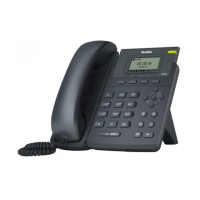Administrator’s Guide for SIP-T2 Series/T19(P) E2/T4 Series IP Phones
32
Configuring the VLAN
If the IP phone is connected to a switch, the switch notifies the IP phone of the VLAN
information defined on the switch (if using LLDP or CDP). The IP phone can then proceed with
the DHCP request for its network settings (if using DHCP). For more information on VLAN, refer
to VLAN on page 63.
Querying the DHCP (Dynamic Host Configuration Protocol) Server
The IP phone is capable of querying a DHCP server. DHCP is enabled on the IP phone by default.
The following network parameters can be obtained from the DHCP server during initialization:
IP Address
Subnet Mask
Default Gateway
Primary DNS (Domain Name Server)
Secondary DNS
You need to configure network parameters of the IP phone manually if any of them is not
supplied by the DHCP server. For more information on configuring network parameters
manually, refer to Configuring Network Parameters Manually on page 45.
Contacting the provisioning server
If the IP phone is configured to obtain configurations from the provisioning server, it will
connect to the provisioning server, download the boot file(s) and configuration file(s) during
startup. The IP phone will be able to resolve and update configurations written in the
configuration file(s). If the IP phone does not obtain configurations from the provisioning server,
the IP phone will use configurations stored in the flash memory. For more information, refer to
Setting Up Your Phones with a Provisioning Server on page 115.
Updating firmware
If the access URL of firmware is defined in the configuration file, the IP phone will download
firmware from the provisioning server. If the MD5 value of the downloaded firmware file differs
from that of the image stored in the flash memory, the IP phone will perform a firmware update.
You can manually upgrade firmware if the IP phone does not download firmware from the
provisioning server. For more information, refer to Upgrading Firmware on page 137.
Downloading the resource files
In addition to configuration file(s), the IP phone may require resource files before it can deliver
service. These resource files are optional, but if some particular features are being deployed,
these files are required.
The followings show examples of resource files:
Language packs
Ring tones

